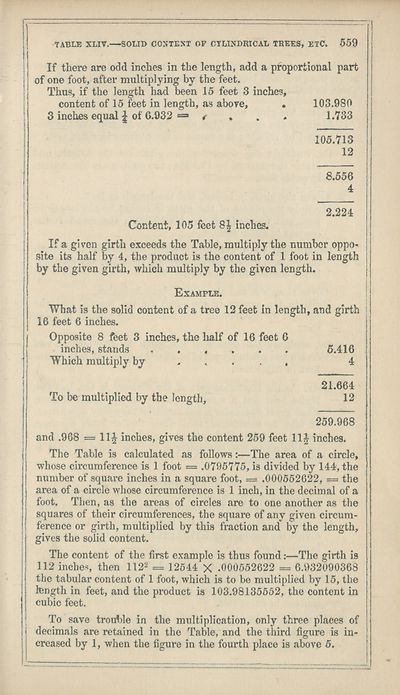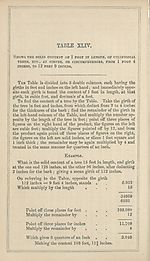Download files
Complete book:
Individual page:
Thumbnail gallery: Grid view | List view

TABLE XLIV. SOLID CONTEXT OF CYLINDRICAL TREES, ETC. 559
If there are odd inches in the length, add a proportional part
of one foot, after multiplying by the feet.
Thus, if the length had been 15 feet 3 inches,
content of 15 feet in length, as above, . 103.980
3 inches equal J of C.932 = • 1.733
105.713
12
8.556
4
2.224
Content, 105 feet inches.
If a given girth exceeds the Table, multiply the number oppo- |;
site its half by 4, the product is the content of 1 foot in length i
by the given girth, which multiply by the given length.
Example.
What is the solid content of a tree 12 feet in length, and girth
16 feet 6 inches.
Opposite 8 feet 3 inches, the half of 16 feet 6
inches, stands 5.416
Which multiply by .... . 4
21.664
To be multiplied by the length, 12
259.968
and .968 = 11J inches, gives the content 259 feet 11J inches.
The Table is calculated as follows:—The area of a circle,
whose circumference is 1 foot = .0795775, is divided by 144, the
number of square inches in a square foot, = .000552622, = the
area of a circle whose circumference is 1 inch, in the decimal of a
foot. Then, as the areas of circles are to one another as the
squares of their circumferences, the square of any given circum¬
ference or girth, multiplied by this fraction and by the length,
gives the solid content.
The content of the first example is thus found:—The girth is
112 inches, then 1122 = 125 44 X .000552622 = 6.932090368
the tabular content of 1 foot, which is to be multiplied by 15, the
length in feet, and the product is 103.98135552, the content in
cubic feet.
| To save trouble in the multiplication, only three places of
j decimals are retained in the Table, and the third figure is in¬
creased by 1, when the figure in the fourth place is above 5.
If there are odd inches in the length, add a proportional part
of one foot, after multiplying by the feet.
Thus, if the length had been 15 feet 3 inches,
content of 15 feet in length, as above, . 103.980
3 inches equal J of C.932 = • 1.733
105.713
12
8.556
4
2.224
Content, 105 feet inches.
If a given girth exceeds the Table, multiply the number oppo- |;
site its half by 4, the product is the content of 1 foot in length i
by the given girth, which multiply by the given length.
Example.
What is the solid content of a tree 12 feet in length, and girth
16 feet 6 inches.
Opposite 8 feet 3 inches, the half of 16 feet 6
inches, stands 5.416
Which multiply by .... . 4
21.664
To be multiplied by the length, 12
259.968
and .968 = 11J inches, gives the content 259 feet 11J inches.
The Table is calculated as follows:—The area of a circle,
whose circumference is 1 foot = .0795775, is divided by 144, the
number of square inches in a square foot, = .000552622, = the
area of a circle whose circumference is 1 inch, in the decimal of a
foot. Then, as the areas of circles are to one another as the
squares of their circumferences, the square of any given circum¬
ference or girth, multiplied by this fraction and by the length,
gives the solid content.
The content of the first example is thus found:—The girth is
112 inches, then 1122 = 125 44 X .000552622 = 6.932090368
the tabular content of 1 foot, which is to be multiplied by 15, the
length in feet, and the product is 103.98135552, the content in
cubic feet.
| To save trouble in the multiplication, only three places of
j decimals are retained in the Table, and the third figure is in¬
creased by 1, when the figure in the fourth place is above 5.
Set display mode to:
![]() Universal Viewer |
Universal Viewer | ![]() Mirador |
Large image | Transcription
Mirador |
Large image | Transcription
| Antiquarian books of Scotland > Occupations > Agriculturist's calculator > (553) |
|---|
| Permanent URL | https://digital.nls.uk/113404488 |
|---|
| Description | Thousands of printed books from the Antiquarian Books of Scotland collection which dates from 1641 to the 1980s. The collection consists of 14,800 books which were published in Scotland or have a Scottish connection, e.g. through the author, printer or owner. Subjects covered include sport, education, diseases, adventure, occupations, Jacobites, politics and religion. Among the 29 languages represented are English, Gaelic, Italian, French, Russian and Swedish. |
|---|

